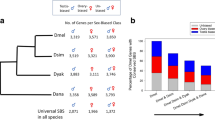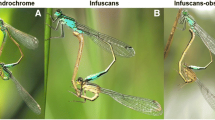Abstract
Studies of the transcriptome have shown that a substantial fraction of interspecific differences in gene expression is the result of sex-biased gene expression. These results suggest that sex-dependent selection may be an important force in generating differences between species but to date all studies have focused on Drosophila. We examined a sample of the transcriptome in the gonads of two species of Xenopus to provide an additional test of how sex-biased gene expression may contribute to differences in gene expression between species. In contrast to Drosophila, Xenopus provides an example of a ZW system with morphologically indistinguishable sex chromosomes. About 81% of the transcriptome was differentially expressed between X. laevis and X. muelleri and there were more genes that were male-biased compared to the number of genes that were female-biased or non-sex-biased. While there were more genes up-regulated in males of Xenopus, the largest magnitude difference in expression between species occurred in female-biased genes, and male-biased genes were proportionally more abundant for the smallest changes in expression between species. Our results suggest that more genes have a role in the function of the testis compared to the ovary and female-biased genes play a principle role in expression divergence between species. These results differ from those in the Drosophila XY system in that more female-biased genes had >4-fold difference of expression between species than male-biased genes, suggesting that ZW sex chromosomes may facilitate enhanced gene expression divergence between species.


Similar content being viewed by others
References
Affymetrix, Inc. (2001) Affymetrix microarray suite user guide, version 5.0. Affymetrix, Santa Clara, CA
Bolstad B (2005) RMAExpress; http://stat-www.berkeley.edu/%7ebolstad/RMAExpress/RMAExpress.html
Bolstad B, Irizarry R, Åstrand M, Speed T (2003) A comparison of normalization methods for high density oligonucleotide array data based on variance and bias. Bioinformatics 19:185–193
Breitling R, Armengaud P, Amtmann A (2005) Vector analysis as a fast and easy method to compare gene expression responses between different experimental backgrounds. BMC Bioinformatics 6:181
Civetta A, Singh RS (1995) High divergence reproductive tract proteins and their association with postzygotic reproductive isolation in Drosophila melanogaster and Drosophila virilis group species. J Mol Evol 6:1085–1095
Connallon T, Knowles LL (2005) Intergenomic conflict revealed by patterns of sex-biased gene expression. Trends Genet 21:495–499
Evans BJ, Kelley DB, Tinsley RC, Melnick DJ, Cannatella DC (2004) A mitochondiral DNA phylogeny of African clawed frogs: phylogeography and implications for polyploid evolution. Mol Phylogenet Evol 33:197–213
Evans BJ, Kelley DB, Melnick DJ, Cannatella DC (2005) Evolution of RAG-1 in polyploid clawed frogs. Mol Biol Evol 22:1193–1207
Fischer WJ, Koch WA, Elepfandt A (2000) Sympatry and hybridization between the clawed frogs Xenopus laevis laevis and Xenopus muelleri (Pipidae). J Zool 252:99–107
Gilad Y, Rifkin SA, Bertone P, Gerstein M, White KP (2005) Multi-species microarrays reveal the effect of sequence divergence on gene expression profiles. Genome Res 15:674–680
Hahn MW, Lanzaro GC (2005) Female-biased gene expression in the malaria mosquito Anopheles gambiae. Curr Biol 15:R192–R193
Haldane JBS (1922) Sex ratio and unisexual sterility in animal hybrids. J Genet 12:101–109
Hayes T (1998) Sex determination and primary sex differentation in amphibians: genetic and developmental mechanisms. J Exp Zool 281:373–399
Hoffman R, Seidl T, Dugas M (2002) Profound effect of normalization on detection of differentially expressed genes in oligonucleotide microarray data analysis. Genome Biol 3:33.1–33.11
Irizarray RA, Wu Z, Jaffee HA (2005) Comparison of Affymetrix GeneChip expression measures. Bioinformatics 1:1–7
Jain N, Thatte J, Braciale T, Ley K, O’Connell M, Lee JK (2003) Local-pooled—error test for identifying differentially expressed genes with a small number of replicated microarrays. Bioinformatics 19:1945–1951
Jiang M, Ryu J, Kiraly M, Duke K, Reinke V, Kim SK (2001) Genome-wide analysis of developmental and sex-regulated gene expression profiles in Caenorhabditis elegans. Proc Natl Acad Sci USA 98:218–223
Jin W, Riley RM, Wolfinger RD, White KP, Passador-Gurgel G, Gibson G (2001) The contributions of sex, genotype and age to transcriptional variance in Drosophila melanogaster. Nat Genet 29:389–395
Jordan IK, Mariño-Ramírez L, Koonin EV (2005) Evolutionary significance of gene expression divergence. Gene 345:119–126
Khaitovich P, Weiss G, Lachmann M, Hellmann I, Enard W, Muetzel B, Wirkner U, Ansorge W, Pääbo S (2004) A neutral model of transcriptome evolution. PLoS Biol 2:682–689
Khil PP, Smirnova NA, Romanienko PJ, Camerini-Otero RD (2004) The mouse X chromosome is enriched for sex-biased genes not subject to selection by meiotic sex chromosome inactivation. Nat Genet 36:642–646
Kleene KC (2005) Sexual selection, genetic conflict, selfish genes, and the atypical patterns of gene expression in spermatogenic cells. Dev Biol 277:16–26
Kobel HR (1985) Sex determination in polyploid Xenopus. S Afr J Sci 81:205–206
Kobel HR (1996) Allopolyploid speciation. In: Tinsley RC, Kobel HR (eds) The biology of Xenopus. Clarendon Press, Oxford, pp 391–401
Kobel HR, Du Pasquier L (1975) Production of large clones of histocompatible, fully identical Clawed Toads (Xenopus). Immunogenetics 2:87–91
Kobel HR, Du Pasquier L, Tinsley RC (1981) Natural hybridization and gene introgression between Xenopus gilli and Xenopus laevis laevis (Anura: Pipidae). J Zool 194:317–322
Kobel HR, Loumont C, Tinsley RC (1996) The extant species. In: Tinsley RC, Kobel HR (eds) The biology of Xenopus. Clarendon Press, Oxford, pp 9–33
Lercher MJ, Urrutia AO, Hurst LD (2003) Evidence that the human X chromosome is enriched for male-specific but not female-specific genes. Mol Biol Evol 20:1113–1116
Li C, Wong WH (2001) Model-based analysis of oligonucleotide arrays: expression index computation and outlier detection. Proc Natl Acad Sci USA 98:31–36
Marinotti O, Calvo E, Nguyen QK, Dissanayake S, Ribeiro JM, James AA (2006) Genome-wide analysis of gene expression in adult Anopheles gambiae. Insect Mol Biol 15:1–12
Meiklejohn CD, Parsch J, Ranz JM, Hartl DL (2003) Rapid evolution of male-biased gene expression in Drosophila. Proc Natl Acad Sci USA 100:9894–9899
Michalak P, Noor MAF (2003) Genome-wide patterns of expression in Drosophila pure-species and hybrid males. Mol Biol Evol 20:1070–1076
Mikamo K, Witschi E (1963) Functional sex-reversal in genetic females of Xenopus laevis, induced by implanted testes. Genetics 48:1411–1421
Mikamo K, Witschi E (1964) Masculinization and breeding of the WW Xenopus. Experientia 20:622–623
Miyata S, Koike S, Kubo T (1999) Hormonal reversal and the genetic control of sex differentiation in Xenopus. Zool Sci 16:335–340
Nishida Y, Yoshioka M, St-Amand J (2005) Sexually dimorphic gene expression in the hypothalamus, pituitary gland, and cortex. Genomics 85:679–687
Nuzhdin SV, Wayne ML, Harmon KL, McIntyre LM (2004) Common pattern of evolution of gene expression level and protein sequence in Drosophila. Mol Biol Evol 21:1308–1317
Parisi M, Nuttall R, Naiman D, Bouffard G, Malley J, Andrews J, Eastman S, Oliver B. (2003) Paucity of genes on the Drosophila X chromosome showing male-biased expression. Science 299:697–700
Parisi M, Nuttall R, Edwards P, Minor J, Naiman D, Lu J, Doctolero M, Vainer M, Chan C, Malley J, Eastman S, Oliver B (2004) A survey of ovary-, testis-, and soma-biased gene expression in Drosophila melanogaster adults. Genome Biol 5:R40
Picker MD (1985) Hybridization and habitat selection in Xenopus gilli and Xenopus laevis in the southwestern Cape Province. Copeia 1985:574–580
Picker MD, de Villiers AL (1989) The distribution and conservation status of Xenopus gilli (Anura: Pipidae). Biol Conserv 49:169–183
Picker MD, Harrison JA, Wallace D (1996) Natural hybridization between Xenopus laevis and X.gilli in the south-western Cape Province, South Africa. In: Tinsley RC, Kobel HR (eds) The biology of Xenopus. Clarendon Press, Oxford, pp 61–71
Ranz JM, Castilo-Davis CI, Meiklejohn CD, Hartl DL (2003) Sex-dependent gene expression and evolution of the Drosophila transcriptome. Science 300:1742–1745
Reinke V, Smith HE, Nance J, Wang J, Van Doren C, Begley R, Jones SJM, Davis EB, Scherer S, Ward S, Kim SK (2000) A global profile of germline gene expression in C. elegans. Mol Cell 6:605–616
Rice WR (1984) Sex chromosomes and the evolution of sexual dimorphism. Evolution 38:735–742
Rifkin SA, Kim J, White KP (2003) Evolution of gene expression in the Drosophila melanogaster subgroup. Nat Genet 33:138–144
Rinn JL, Rozowsky JS, Laurenzi IJ, Peterson PH, Zou K, Zhong W, Gerstein M, Snyder M (2004) Major differences between mammalian sexes are involved in drug metabolism and renal function. Dev Cell 6:791–800
Saifi GM, Chandra HS (1999) An apparent excess of sex- and reproduction-related genes on the human X chromosome. Proc R Soc Lond Biol Sci 266:203–209
Schmid M, Steinlein C (1991) Chromosome banding in Amphibia, XVI. High-resolution replication banding patterns in Xenopus laevis. Chromosoma 101:123–132
Sokal RR, Rohlf FJ (2001) Biometry: the principles and practice of statistics in biological research, 3rd ed. W.H. Freeman, New York
Storey JD, Taylor JE, Siegmund D (2004) Strong control, conservative point estimation and simultaneous conservative consistency of false discovery rates: a unified approach. J R Stat Soc Ser B Stat Methodol 66:187–205
Swanson WJ, Vacquier VD (2002a) Reproductive protein evolution. Annu Rev Ecol Syst 33:161–179
Swanson WJ, Vacquier VD (2002b) Rapid evolution of reproductive proteins. Nat Rev Genetics 3:137–144
Swanson WJ, Clark AG, Waldrip-Dail HM, Wolfner MF, Aquadro CF (2001) Evolutionary EST analysis identifies rapidly evolving male reproductive proteins in Drosophila. Proc Natl Acad Sci USA 98:7375–7379
Tymowska J, Kobel HR (1972) Karyotype analysis of Xenopus muelleri (Peters) and Xenopus laevis (Daudin), Pipidae. Cytogenetics 11:270–278
Wang PJ, McCarrey JR, Yang F, Page DC (2001) An abundance of X-linked genes expressed in spermatogonia. Nat Genet 27:422–426
Witschi E (1971) Mechanisms of sexual differentiation. In: Hamburg M, Barrington E (eds) Hormones in development. Appleton Century Crofts, New York, pp 601–618
Wu C-I, Davis AW (1993) Evolution of postmating reproductive isolation: the composite nature of Haldane’s rule and its genetic basis. Am Nat 142:187–212
Wu C-I, Xu EY (2003) Sexual antagonism and X inactivation—the SAXI hypothesis. Trends Genet 19:243–247
Wu C-I, Johnson NA, Palopoli MF (1996) Haldane’s rule and its legacy: Why are there so many sterile males? Trends Ecol Evol 11:281–284
Wycoff GJ, Wang W, Wu C-I (2000) Rapid evolution of male reproductive genes in the descent of man. Nature 403:304–309
Zhang Z, Parsch J (2005) Positive correlation between evolutionary rate and recombination rate in Drosophila genes with male-biased expression Mol Biol Evol 22:1945–1947
Zhang Z, Hambuch TM, Parsch J (2005) Molecular evolution of sex-biased genes in Drosophila. Mol Biol Evol 21:2130–2139
Acknowledgments
We thank Professor R.C. Tinsley for donating specimens of Xenopus muelleri for use in this study and E. Betrán for insightful discussions on sex-biased gene expression. We also thank Jacob Malcom and three anonymous reviewers who all provided insightful comments and suggestions that were crucial to completing the final version of the manuscript. This work was conducted following the protocols of The University of Texas—Arlington Animal Care Committee (Protocol No. A05.001). Funding was provided by a National Science Foundation Dissertation Improvement Grant (DEB-0508882) and Texas Academy of Science Student Research Grant to J.H.M.
Author information
Authors and Affiliations
Corresponding author
Additional information
Reviewing Editor: Dr. David Pollock
Electronic Supplementary Material
Rights and permissions
About this article
Cite this article
Malone, J.H., Hawkins, D.L. & Michalak, P. Sex-Biased Gene Expression in a ZW Sex Determination System. J Mol Evol 63, 427–436 (2006). https://doi.org/10.1007/s00239-005-0263-4
Received:
Accepted:
Published:
Issue Date:
DOI: https://doi.org/10.1007/s00239-005-0263-4




